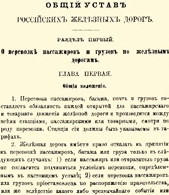
The first General Statute of Russian Railways and the Regulations of Railways Affairs Council adopted
12 (24) June 1885 Emperor Alexander III signed the first General Statute of the Russian Railways, and the Regulations of the Council on Railway Affairs.
From January to April 1885 a draft of the General Statute and Regulations of the Council on Railway Affairs was considered by the United Departments of the State Council. In June, these issues were discussed at its general meeting, and 12 (24) June the Statute and the Regulations of the Council were approved by Alexander III.
The Statute of Railways was a major railroad law and established uniform legal rules for railway service. It regulated the activities and statements of the transport authorities, the order of transportation of people and goods. The Statute included three parts: "The section on transportation of passengers and goods by rail," "The section of the rules on jurisdiction and limitation of railroad actions and on the order of execution of decisions on claims against the railroads," "The section of railway police regulations."
In order to develop of the General Statute of the Russian railways in 1888-1889, on the entire network was introduced a direct service without transshipment. This dramatically accelerated the circulation of wagons and improved utilization of rolling-stock. The establishment of a system of special bodies of the Ministry of Railways for operational control and management of operational work, which was a major step towards improving the management of the railways of the country, also contributed to the fact. The system of direct service without transshipment on the railways of Russia was more progressive in comparison with Western European countries and the USA.
The Council on Railway Affairs established by the Regulations was created under the Ministry of Railways (MPS) and was its advisory body, uniting activities of various agencies in arrangement, maintenance and operation of railways, both private and governmental.
The Council chaired by the Minister of Transport, besides the officials of various departments, included representatives of commerce, industry and private railways.
The Council considered the new draft laws on railway operation, rules and regulations, train fares and additional charges, the cases within the jurisdiction of the Council Resolutions of the General Statute of the Russian Railways and the issues that the Minister of Transport or other heads of management recognized as subject to discussion in the Council.
With the establishment of the Council on Tariffs under the Ministry of Finance on 8 (20) March 1889, all such cases were no longer under the jurisdiction of the Council on Railway Affairs. Thus the basic category of cases considered by the Council became those concerning the conditions of transport, the agreements between roads, the differences between the railway companies, the liquidation of railway companies.
With the adoption of the General Statue of the Russian Railways - the first special source of railway legislation, of the nature of codification regulatory legal act obligatory both for State-owned and private railways - was the beginning of the formation of a single legal space in the network of Russian railways. It was of great importance for the further development of rail transport and, consequently, the country's economic development. General Statute of the Russian Railways had to lay a solid state foundation for the railway transport operation and regulate the activities and responsibilities of the railway administration.
With a large number of additions and amendments to certain articles, the General Statute of the Russian Railways existed until 1920, when by the General Statute of Railways of the RSFSR was introduced.
Lit.: Гросс О., Чукарев А. В середине 80-х годов XIX века в России введён в действие первый железнодорожный устав // Северная магистраль. 22—28 апр. (№ 15); Елютин О. Н. «Золотой век» железнодорожного строительства в России и его последствия // Вопросы истории. 2004. № 2. С. 47-57; История железнодорожного транспорта России. Т. 1. 1836–1917. СПб.; М., 1994; Кислинский Н. А. Наша железнодорожная политика по документам архива Комитета министров. Т. 3. СПб., 1902; Кульжинский С. О реорганизации центральных установлений Министерства путей сообщения по управлению железными дорогами // Особая Высшая комиссия по всестороннему обследованию железнодорожного дела в России. Вып. 58. СПб., 1911; Мишина Н. В. Этапы развития правовой политики на железнодорожном транспорте // Железнодорожный транспорт. 2007. № 5.
From the Presidential library materials:

